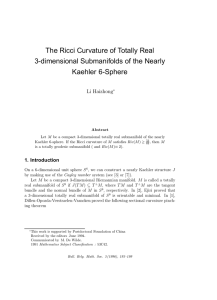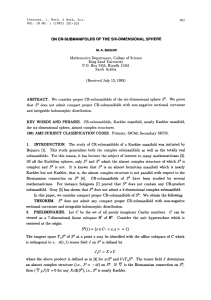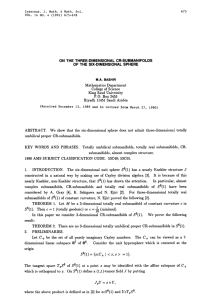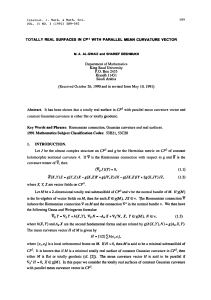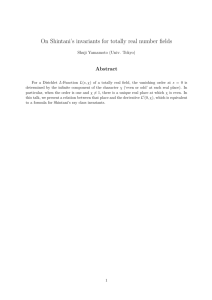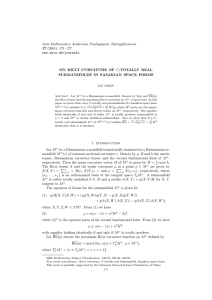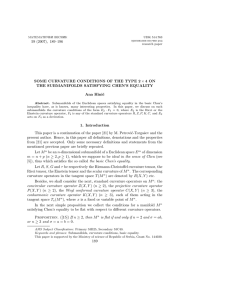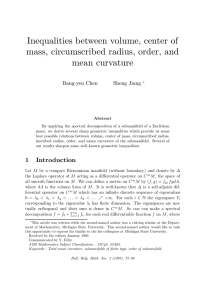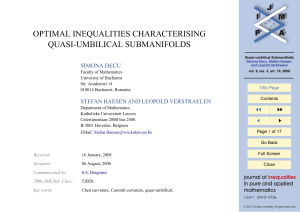TOTALLY REAL SUBMANIFOLDS IN A COMPLEX PROJECTIVE SPACE LIU XIMIN
advertisement
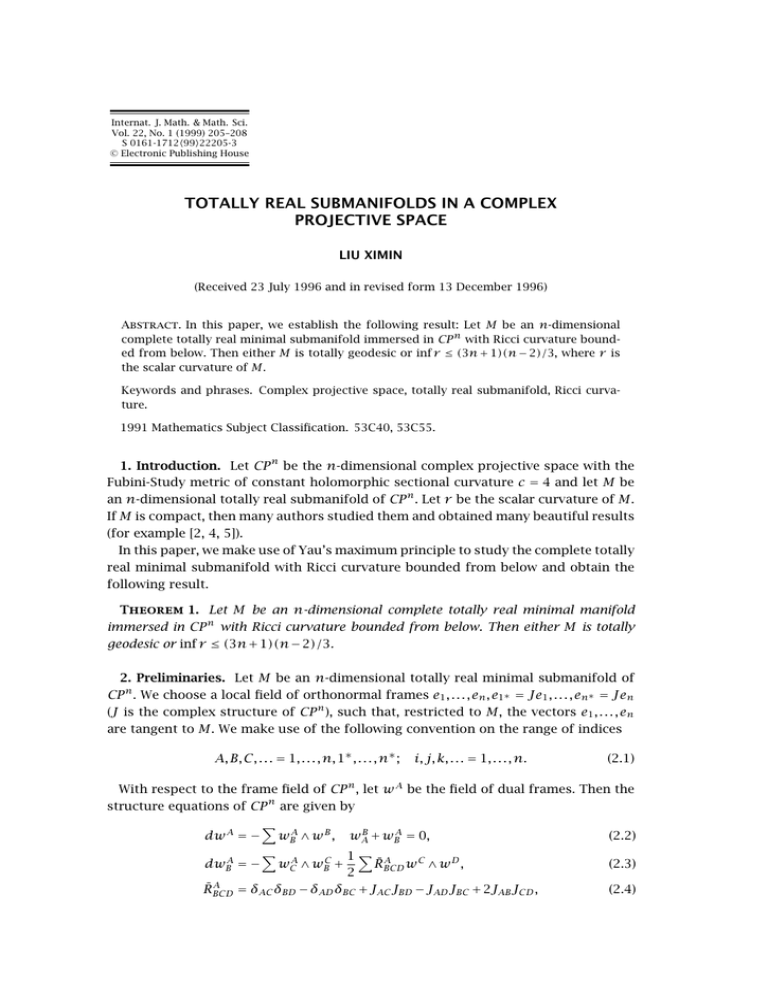
Internat. J. Math. & Math. Sci.
Vol. 22, No. 1 (1999) 205–208
S 0161-17129922205-3
© Electronic Publishing House
TOTALLY REAL SUBMANIFOLDS IN A COMPLEX
PROJECTIVE SPACE
LIU XIMIN
(Received 23 July 1996 and in revised form 13 December 1996)
Abstract. In this paper, we establish the following result: Let M be an n-dimensional
complete totally real minimal submanifold immersed in CP n with Ricci curvature bounded from below. Then either M is totally geodesic or inf r ≤ (3n + 1)(n − 2)/3, where r is
the scalar curvature of M.
Keywords and phrases. Complex projective space, totally real submanifold, Ricci curvature.
1991 Mathematics Subject Classification. 53C40, 53C55.
1. Introduction. Let CP n be the n-dimensional complex projective space with the
Fubini-Study metric of constant holomorphic sectional curvature c = 4 and let M be
an n-dimensional totally real submanifold of CP n . Let r be the scalar curvature of M.
If M is compact, then many authors studied them and obtained many beautiful results
(for example [2, 4, 5]).
In this paper, we make use of Yau’s maximum principle to study the complete totally
real minimal submanifold with Ricci curvature bounded from below and obtain the
following result.
Theorem 1. Let M be an n-dimensional complete totally real minimal manifold
immersed in CP n with Ricci curvature bounded from below. Then either M is totally
geodesic or inf r ≤ (3n + 1)(n − 2)/3.
2. Preliminaries. Let M be an n-dimensional totally real minimal submanifold of
CP n . We choose a local field of orthonormal frames e1 , . . . , en , e1∗ = Je1 , . . . , en∗ = Jen
(J is the complex structure of CP n ), such that, restricted to M, the vectors e1 , . . . , en
are tangent to M. We make use of the following convention on the range of indices
A, B, C, . . . = 1, . . . , n, 1∗ , . . . , n∗ ;
i, j, k, . . . = 1, . . . , n.
(2.1)
With respect to the frame field of CP n , let w A be the field of dual frames. Then the
structure equations of CP n are given by
wAB + wBA = 0,
1 A
dwBA = − wCA ∧ wBC +
R̄BCD w C ∧ w D ,
2
A
R̄BCD
= δAC δBD − δAD δBC + JAC JBD − JAD JBC + 2JAB JCD ,
dw A = −
wBA ∧ w B ,
(2.2)
(2.3)
(2.4)
206
LIU XIMIN
where J = JAB eA ⊗ eB , so that
JAB
0
=
In
−In
,
0
(2.5)
where In is the identity matrix of order n. We restrict these forms to M. Then from
[2], we have
∗
j
j∗
∗
j∗
w i = 0, wi = wi∗ , wji = wi ,
∗
∗
∗
∗
∗
j∗
wik = hkij w j , hkij = hkji = hijk = hik ,
j
dw i = − wji ∧ w j , wi + wji = 0,
1 j
j
j
dwi = − wik ∧ wk +
Rikl w k ∧ w l ,
2
∗ m∗
i
i
m∗ m∗
Rjkl
= R̄jkl
wk +
hm
,
ik hjl − hil hjk
1
∗
∗
∗
∗
dwji∗ = − wki ∗ ∧ wjk∗ +
Rji ∗ kl w k ∧ w l ,
2
∗ j∗
∗
∗
∗
j∗
Rji ∗ kl = R̄ji ∗ kl +
hikm hml − himl hkm .
(2.6)
(2.7)
(2.8)
(2.9)
(2.10)
(2.11)
(2.12)
∗
The second fundamental form h of M in CP n is defined as h = hkij w i ⊗ek∗ , whose
∗ 2
squared length is h
2 =
hkij .
n
If M is minimal in CP , i.e., trace h = 0, then from (2.4) and (2.10), we have
r = n(n − 1) − h
2 ,
(2.13)
where r is the scalar curvature of M.
∗
m∗
Define hm
ijk and hijkl by
∗
∗
∗
∗
k
k
hm
hm
hlij wlm
∗ ,
kj wi −
ik wj +
∗
∗
∗
∗
∗
∗
m∗
l
l
l
l
hm
hm
hm
hm
hlijk wlm
∗ ,
ijkl w = dhijk −
ljk wi −
ilk wj −
ijl wk +
∗
∗
m
k
hm
ijk w = dhij −
(2.14)
(2.15)
respectively.
∗
Let Hl∗ and ∆ denote the (n×n)-matrix hlij and the Laplacian on M, respectively.
By a simple calculation, we have (cf. [2])
∗ 2
2
1
∆
h
2 =
hlijk + (n + 1)
h
2 + tr Hi∗ Hj ∗ − Hj ∗ Hi∗
2
2
−
tr Hi∗ tr Hj ∗ .
(2.16)
The following lemma is important in this paper.
Lemma 1 [6]. Let M n be a complete Riemannian manifold with Ricci curvature bounded from below and let f be a C 2 -function bounded from above on M n , then for all
> 0, there exists a point x ∈ M n at which
(i) sup f − < f (x);
(ii) ∇f (x)
< ;
(iii) ∆f (x) < .
TOTALLY REAL SUBMANIFOLDS IN A COMPLEX PROJECTIVE SPACE
207
2
tr Hi2∗ . From
Proof of the main theorem. By [3], we have (tr Hi∗ Hj ∗ )2 =
2
[1], we know that tr(Hi∗ Hj ∗ − Hj ∗ Hi∗ )2 −
tr Hi2∗ ≥ −3/2
h
4 . So, from (2.16),
we obtain
1
∆
h
2 ≥ h
2 (n + 1) − 3/2
h
2 .
(2.17)
2
We know that h
2 = n(n − 1) − r . By the condition of the theorem, we conclude that
h
2 is bounded. We define f = h
2 and F = (f + a)1/2 (where a > 0 is any positive
constant number). F is bounded. We have
1
(f + a)−1/2 df ,
2
1 1
∆F =
− (f + a)−3/2 df 2 + (f + a)−1/2 ∆f
2
2
1
=
− 2
dF 2 + ∆f (f + a)−1/2 ,
2
dF =
(2.18)
(2.19)
i.e.,
∆F =
1 − 2
dF 2 + ∆f .
2F
(2.20)
Hence, F ∆F = −
dF 2 + 1/2∆f or 1/2∆f = F ∆F + dF 2 .
Applying Lemma 1 to F , we have for all > 0, there exists a point x ∈ M such that
at x
dF (x) < ;
(2.21)
∆F (x) < ;
(2.22)
F (x) > sup F − .
(2.23)
From (2.21), (2.22), and (2.23), we have
1
∆f < 2 + F = ( + F ).
2
(2.24)
We take a sequence {m } such that m → 0(m → ∞) and for all m, there exists a
point xm ∈ M such that (2.21), (2.22), and (2.23) hold. Therefore, m (m + F (xm )) →
0(m → ∞) (because F is bounded).
From (2.23), we have F (xm ) > sup F − m . Because {F (xm )} is a bounded sequence.
So we get F (xm ) → F0 (if necessary, we can choose a subsequence). Hence, F0 ≥ sup F .
So we have
F0 = sup F .
(2.25)
f (xm ) → f = sup f .
(2.26)
From the definition of F , we get
(2.17) and (2.24) imply that
1
3
f (n + 1) − f ≤ ∆f ≤ ( + F ),
2
2
(2.27)
and
3
2
2
+ m F (xm ) ≤ m
+ m F0
f (xm ) (n + 1) − f (xm ) < m
2
(2.28)
208
LIU XIMIN
let m → ∞, then m → 0 and f (xm ) → f0 . Hence,
3 f0 (n + 1) − f0 ≤ 0.
2
(2.29)
(i) if f0 = 0, we have f = h
2 ≡ 0. Hence, M is totally geodesic.
(ii) if f0 > 0, we have (n + 1) − 3/2f0 ≤ 0 and f0 ≥ 2/3(n + 1), that is, sup h
2 ≥
2/3(n + 1). Therefore, inf r ≤ (3n + 1)(n − 2)/3. This completes the proof.
Acknowledgement. The author is grateful to the referee for the careful reading
and the very helpful comments on the earlier versions of this manuscript.
References
[1]
[2]
[3]
[4]
[5]
[6]
L. An Min and L. Jimin, An intrinsic rigidity theorem for minimal submanifolds in a sphere,
Arch. Math. (Basel) 58 (1992), no. 6, 582–594. MR 93b:53050. Zbl 767.53042.
B. Y. Chen and K. Ogiue, On totally real submanifolds, Trans. Amer. Math. Soc. 193 (1974),
257–266. MR 49 11433. Zbl 286.53019.
S. S. Chern, M. do Carmo, and S. Kobayashi, Minimal submanifolds of a sphere with second
fundamental form of constant length, Functional Analysis and Related Fields (Proc.
Conf. for M. Stone, Univ. Chicago, 1968) (New York), vol. Ill, Springer-Verlag, 1970,
pp. 59–75. MR 42#8424. Zbl 216.44001.
G. D. Ludden, M. Okumura, and K. Yano, A totally real surface in CP 2 that is not totally geodesic, Proc. Amer. Math. Soc. 53 (1975), no. 1, 186–190. MR 52 1580. Zbl 312.53043.
Y. B. Shen, Scalar curvature for totally real minimal submanifolds, Chinese Ann. Math. Ser.
A 12 (1991), no. 5, 573–577 (Chinese). MR 93a:53052. Zbl 777.53055.
S. T. Yau, Harmonic functions on complete Riemannian manifolds, Comm. Pure Appl. Math.
28 (1975), 201–228. MR 55 4042. Zbl 297.31005.
Ximin: Department of Mathematics, Nankai University, Tianjin 300071, China
Current address: Department of Applied Mathematics, Dalian University of Technology, Dalian 116024, China
E-mail address: xmliu@dlut.edu.cn

